Topics
- Article
- Recovery
- Training & Exercise
Patrick Mahomes: The Data Behind an NFL Season with WHOOP
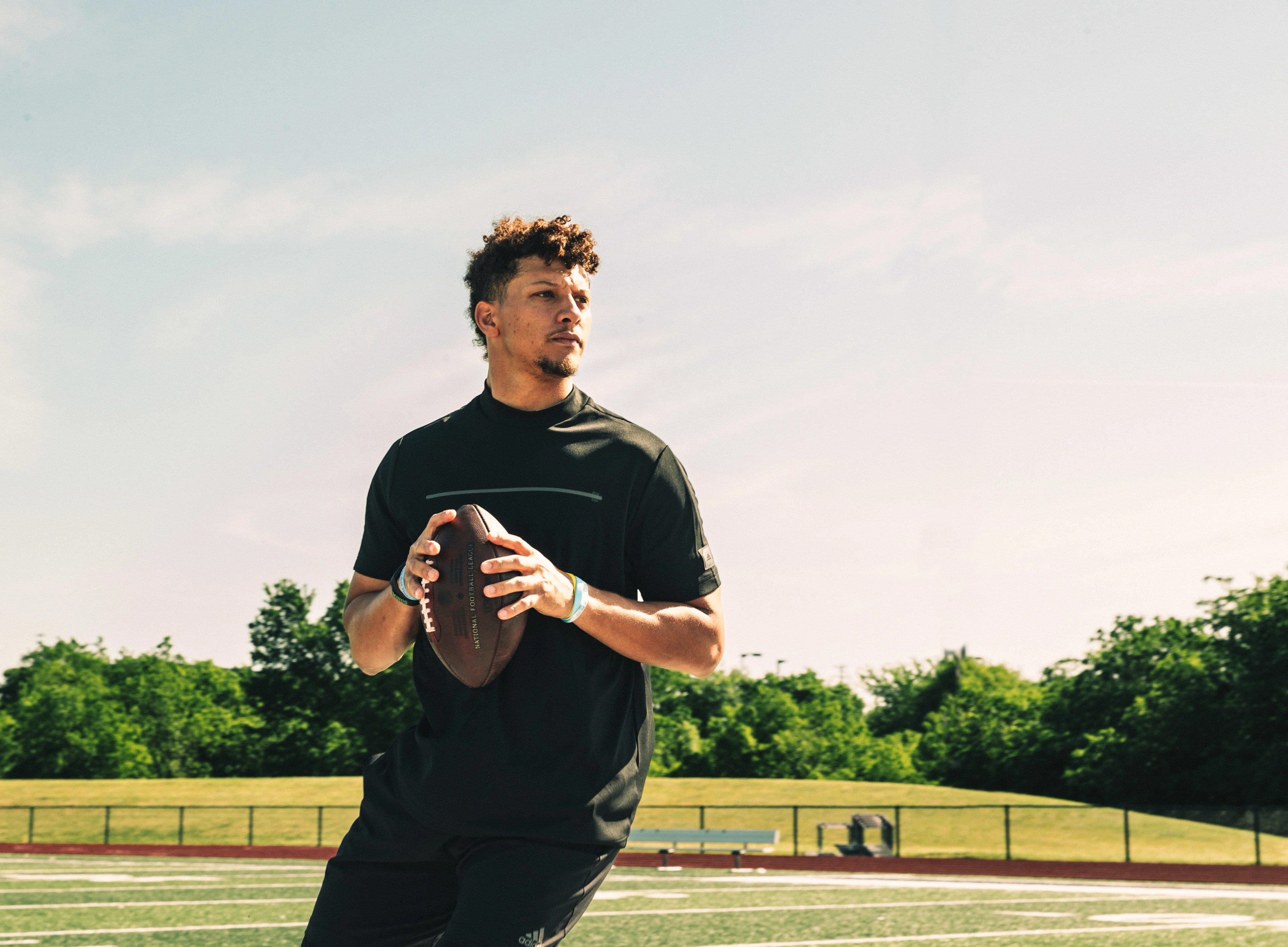
The 2022 NFL season kicks off and WHOOP shares new insights from World Champion QB Patrick Mahomes
The NFL season is a grueling 7 months of practice, competition, and recovery. Throughout it all, how does a player’s health change from preseason to postseason? What goes into the offseason to get ready to do it all again? We take a look back at Patrick Mahomes’ 2021 NFL data to understand how he prepares to peak this season.
A YEAR IN SLEEP, STRAIN & RECOVERY
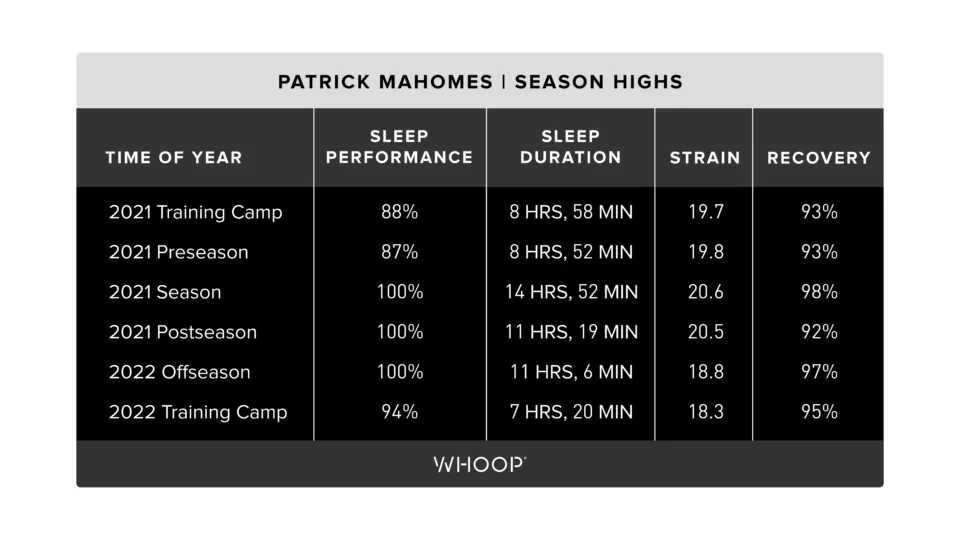
The three pillars of WHOOP are Recovery (how ready your body is to perform from 0-100%), Strain (cardiovascular exertion on a 0-21 scale), and Sleep. From the start of training camp on July 28, 2021 through August 25, 2022, here are Mahomes’ highest totals across each phase of the year:
Going deeper into the data of each part of the 2021 season, Mahomes racked up his highest average strain as well as his highest average recovery during training camp. The higher average strain is likely a result of Mahomes’ body reacclimating and ramping up to the intensity of football. At the same time, the increased average recovery highlights the balance needed to prepare for the long season to come.
Sleep plays an integral role in recovery and the high individual days during the regular season and postseason show just how much is required of Mahomes to keep up. In fact, he clocked in his highest average sleep period during the playoffs – an 8.1% increase compared to the regular season – so he was primed for the biggest games of the year.
STRAIN: THE REGULAR SEASON VS. OFFSEASON
WHOOP quantifies the amount of physical and mental stress you put on your body. Strain is tracked as an overall total for the entire day and can be broken down by specific workouts and activities.
With Sundays normally being game days, there are clear strain trends throughout the week. Mahomes averaged a 19.5 day strain on Sundays during the regular season which is almost equivalent to the cardiovascular exertion of running a marathon. Below is a chart depicting Mahomes’ average strain for each day of the week across the 2021 regular season compared to the offseason:
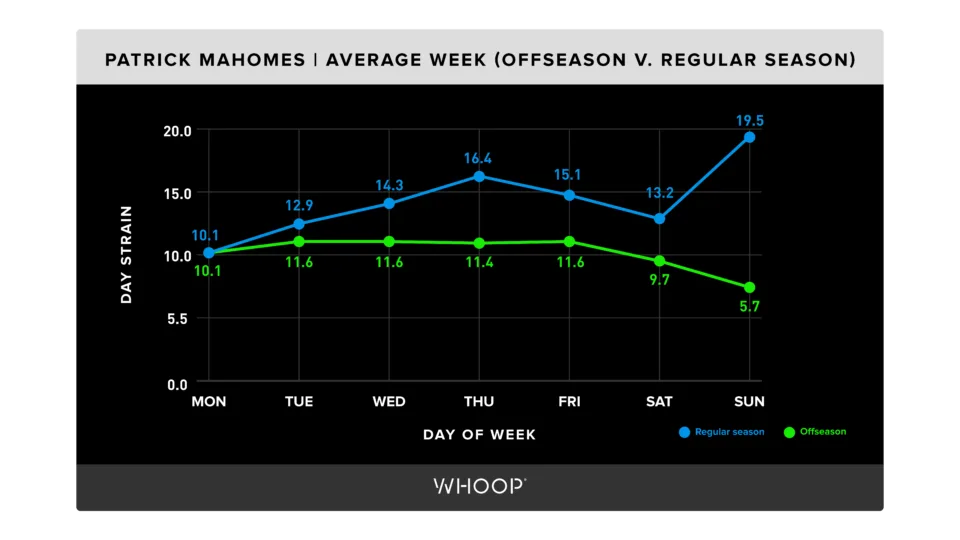
Mahomes' best recovery day during the regular season was Sunday (73.5% on average) so he was ready to take on strain and, unsurprisingly, his worst was Monday (57.8%). On those Mondays, Mahomes prioritizes rest and keeping his lower average strain. After that initial day of recovery, he ramps training back up again through the week before focusing again on moderate strain to be fully recovered for the next opponent. In the offseason, Mahomes maintains a consistently lower level of strain, but pulls back even more on the weekends to take full advantage of rest days.
FULL GAME HEART RATE, STRAIN & CALORIES
On January 24, 2021, Mahomes led the Kansas City Chiefs to an all-time playoff win against the Buffalo Bills in an overtime thriller. In total, Mahomes’ activity strain during the game was 18.8 with 2,347 calories burned, and his day strain was 20.4.
Mahomes’ heart rate reached a game high at 191 beats per minute (bpm) during his rushing touchdown in the first quarter. Below is Mahomes’ heart rate data for the entire game:
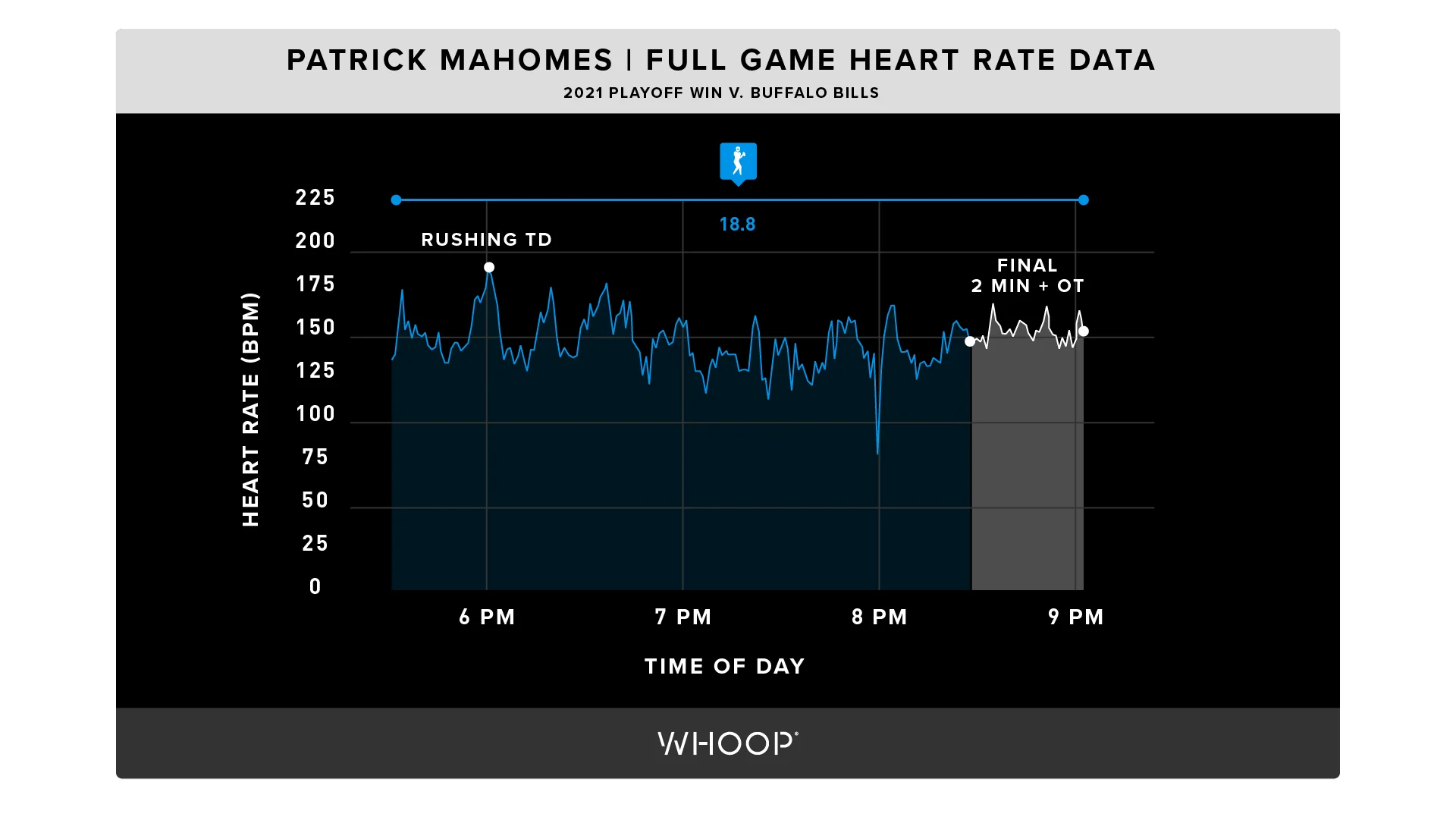
In overtime, Mahomes’ heart rate actually spiked in the moments when he was on the sideline watching the opposing team try to score, and it stayed even when he was on the field in the heat of competition. Mahomes’ personal trainer Bobby Stroupe notes that this type of experience is a flow state - where you’re totally focused and all of your energy is so in the moment that nothing can distract you.
During practice sessions, Stroupe tries to desensitize Mahomes to “free flow a movement to where it’s more natural and reactive.” Stroupe creates competitive situations in practice with just one rep or set because it forces the mindset that there’s no second or third shot at getting it right. “There’s a neural component to knowing that there’s no take backs” and consistently training like that prepares Mahomes for those moments.
THE IMPACT OF AN NFL SEASON
Going beyond strain and in-game highlights, recovery helps you understand how hard you can push yourself. Resting heart rate (RHR) and heart rate variability (HRV) are two key components of WHOOP recovery which also provide greater insight into overall health.
RHR is a measure of your average heart beats per minute while you’re in a state of complete rest and it’s an important metric for monitoring fitness level. HRV is literally the variance or time in between heart beats. It’s a measure of your autonomic nervous system and considered one of the best objective metrics for determining your body’s readiness to perform.
Below is an overview of Mahomes’ HRV and RHR trends throughout the different stages of the 2021 season leading into the 2022 opener:
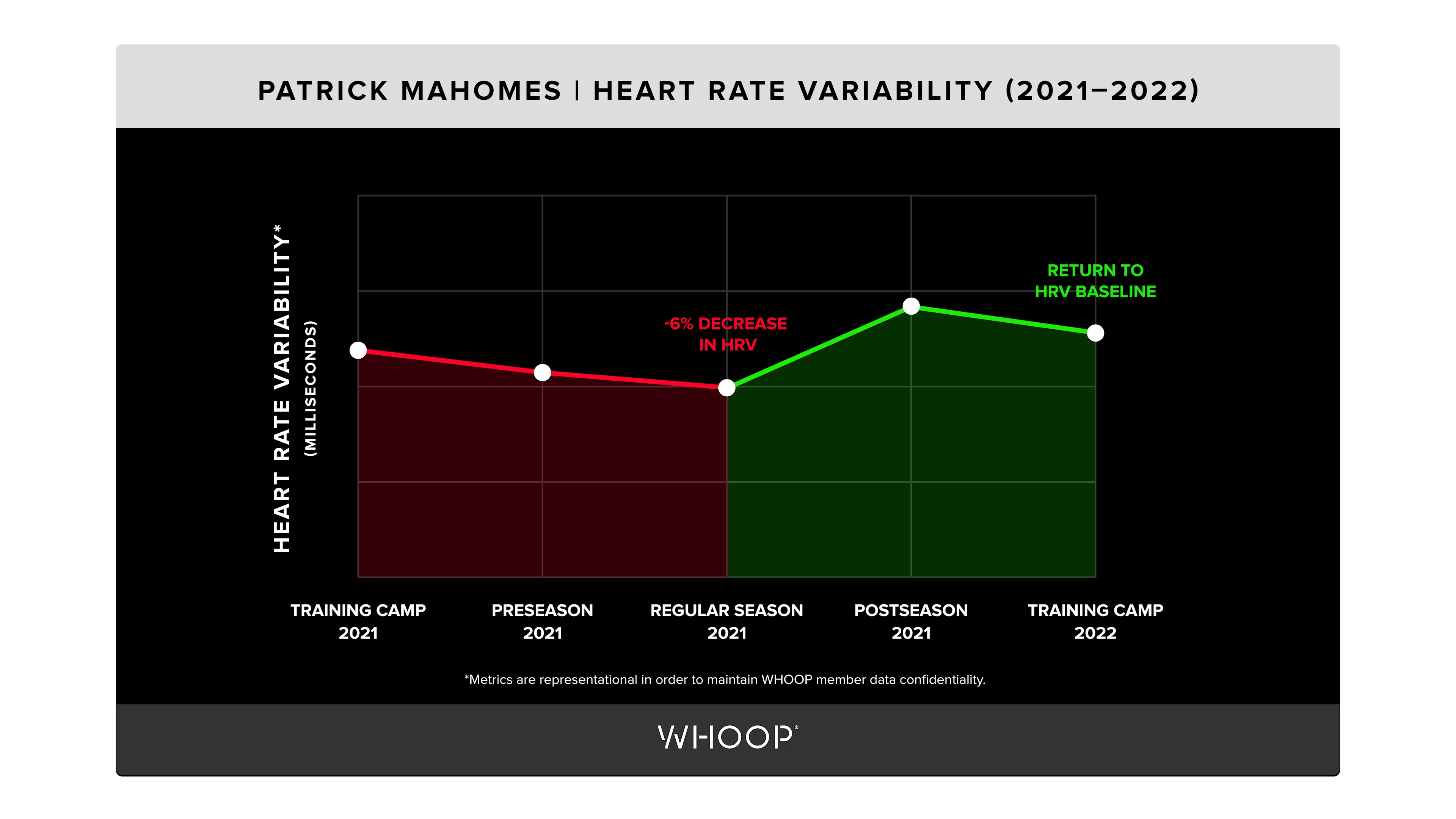
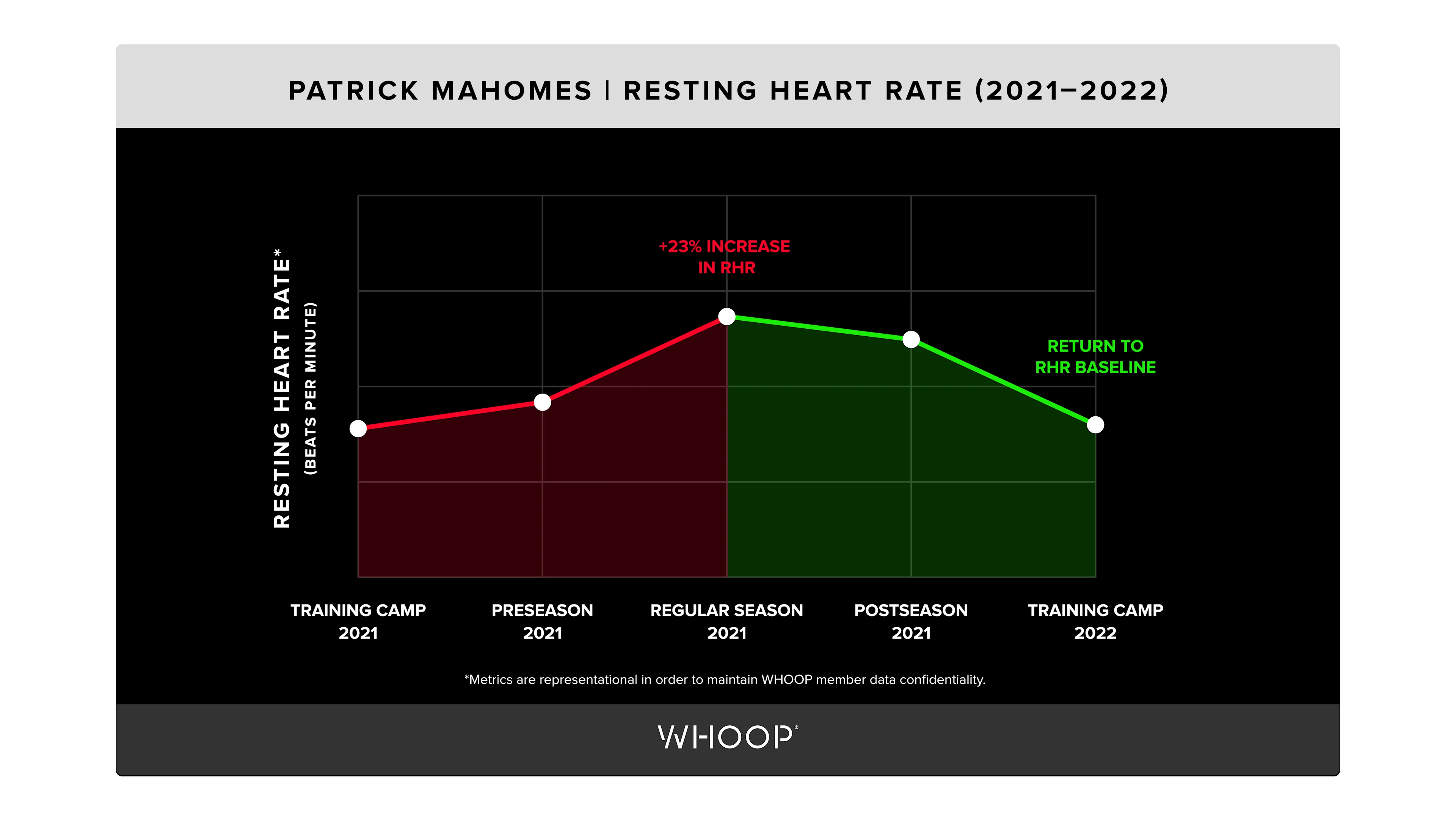
The long-term view of Mahomes’ data highlights the serious amount of stress his body takes on month to month and the grind of the NFL season.
If you’re looking to improve your overall health over time, you want to see your average RHR go down and your average HRV gradually increase. From the beginning of training camp 2021 through the regular season, Mahomes’ RHR increased by 23.2% and his HRV decreased by 6.8%. The data paint a clearer picture of just how much that accumulated exertion weighs on Mahomes.
Despite these trends, Mahomes’ HRV shot up to its highest seasonal average during the playoffs as he focused on rest and recovery. Heading into the 2022 season, we see his RHR and HRV return to his normal baseline as he prepares his body to do it all again.
RECOVERY: PREPARING FOR THE 2022 SEASON
Mahomes is one of the best athletes in the world and he works hard to maintain his body’s fitness baseline so he can take on the rigors of the NFL and effectively prepare to peak on the right day each week. During 2021, he experienced his best recovery (98%) in a Week 15 victory over the Chargers as well as a strong recovery (92%) in the AFC Championship.
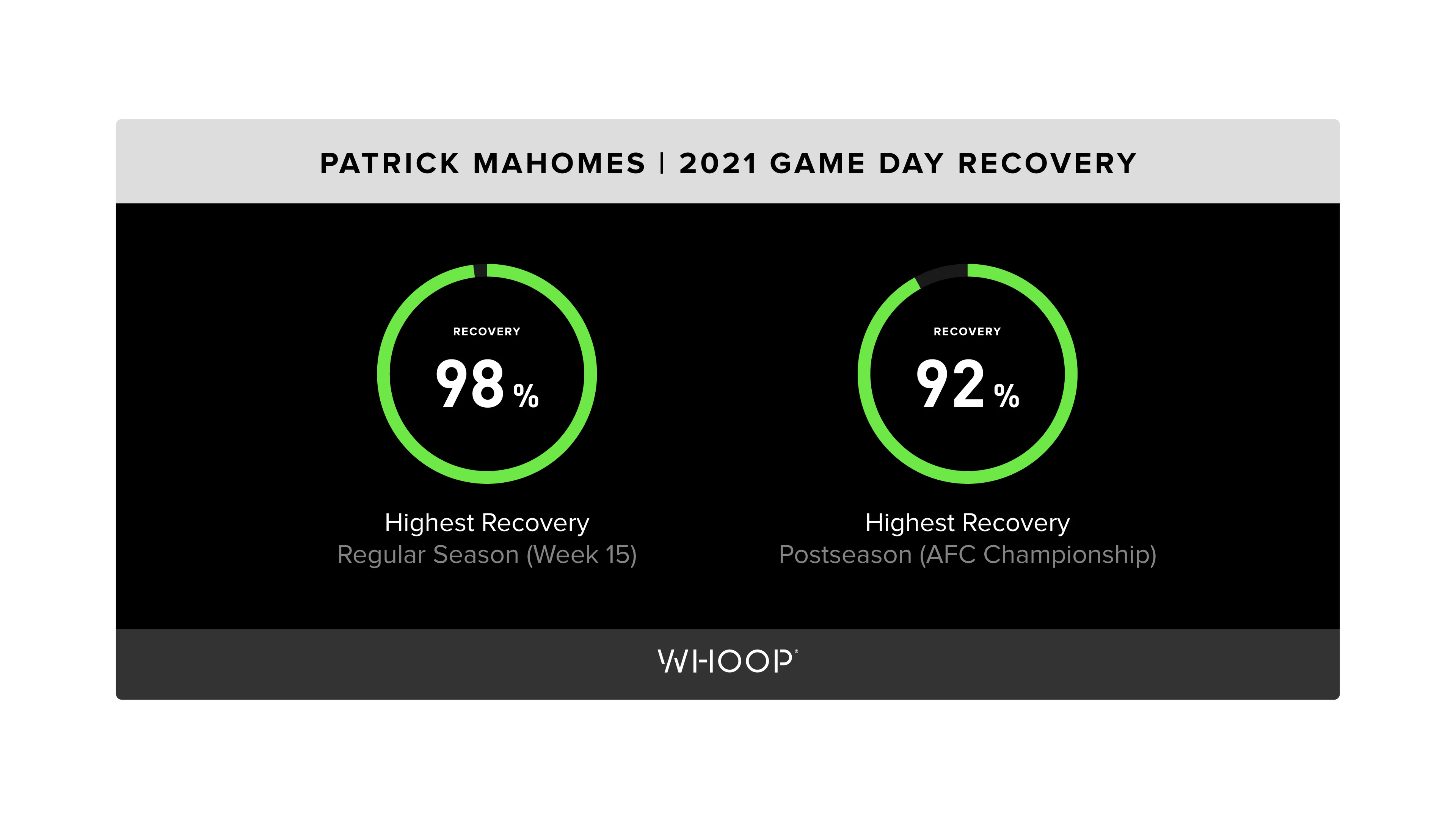
Heading into his sixth NFL season, Mahomes had to deal with different challenges than in years past including building chemistry with a new wide receiver core. That pressure to perform isn’t new for Mahomes though and he relies heavily on recovery to stay ready for whatever the season throws at him.
At the end of the 2021 season, Mahomes underwent successful toe surgery following a playoff injury. Stroupe noted that offseason workouts almost doubled in length to four hours to include physical therapy. Despite the longer days, Mahomes’ strain was lower than usual with efforts geared towards recovery and getting back to his baseline.
In the lead up to the 2022 season, Stroupe and a healthy Mahomes focused on unlocking his physiological potential. Stroupe shared that Mahomes has made a transition and they’ve, “been able to throw more than they have in the past three years while focusing more on movement and power capabilities.” They haven’t stopped working since the end of last season and Stroupe believes “all signs are pointing to Mahomes being in a place to play the game only he can.”
PATRICK’S PASSIONS: TRACKING GOLF V. FOOTBALL
While his focus is on football year-round, Mahomes is able to take a step back during the offseason, spend more time with his family, and take up other interests that challenge his mind and body.
In reviewing golf activities during the time between the 2021 and 2022 season, Mahomes average max heart rate was 154.2 bpm with an average heart rate of 119.8 bpm. His golf sessions were typically 2 hours and 15 minutes, burning approximately 830 calories while accruing a 10.97 average strain.
Below is an example of Mahomes’ data from one golf outing in June 2021 compared to Week 8 win over the Giants on Monday, November 1, 2021:

The aerobic heart rate zone is a heart rate between 70% and 80% of your maximum heart rate. When it comes to individual workouts, more intense aerobic exercise leads to higher strain than less intense activity. The average strain of 1 hour of running is roughly 12.0. While playing golf, Mahomes spends most of his time in two main heart rate zones (50-60% and 60-70%) and Stroupe likes when he walks the course for a different aerobic benefit. These are very light to light exertion levels which can help build basic endurance over a long period of exercise or serve as active recovery. Stroupe thinks golf is good offseason cross-training which teaches frontal plane power, adding that “frontal plane development helps the body produce power at different angles.”
An NFL game is clearly more strenuous than a golf outing, but the length of a day at the course can still have an impact on your body. When he reports to training camp, Mahomes puts his golf clubs away for the season and puts all of himself into football.